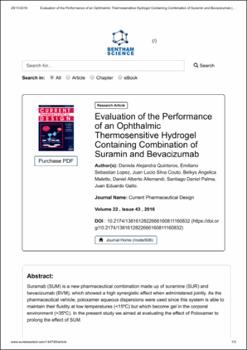Evaluation of the Performance of an Ophthalmic Thermosensitive Hydrogel Containing Combination of Suramin and Bevacizumab.

View/
Date
2016Author
Quinteros, Daniela.
Lopez, Emiliano S.
Couto, Juan L.
Maletto, Belkys A.
Allemandi, Daniel A.
Palma, Santiago D.
Gallo, Juan E.
Metadata
Show full item recordAbstract
Suramab (SUM) is a new pharmaceutical combination made up of suramine (SUR) and bevacizumab (BVM), which showed a high synergistic effect when administered jointly. As the pharmaceutical vehicle, poloxamer aqueous dispersions were used since this system is able to maintain their fluidity at low temperatures (<15ºC) but which become gel in the corporal environment (>35ºC). In the present study we aimed at evaluating the effect of Poloxamer to prolong the effect of SUM. These formulations were characterized using rheological, biopharmaceutical (drug release) and morphological (SEM) technique. Corneal NV was induced in Sprague Dawley rats Corneal. At 15 days of follow up animals were sacrificed and perfused with black drawing ink. Digital photographs were taken and the area of neovascularisation (ANV) was calculated using the image programmed. The rheological behavior was influenced by the addition of drugs, resulting in a decrease in the gelation temperature (Tsol/gel). Both drugs were released from poloxamer gels by means of an anomalous mechanism. However, BVM was released faster than SUR, with their combination (SUM) to appearing to reduce delivery, probably due to interactions between the drugs or with the polymeric matrix. The in vivo studies showed that SUM-poloxamer gel was able to increase the corneal antiangiogenic effect compared to the SUM solution and BVM alone at 15 days of follow-up. Furthermore no injurious effects were observed in the histological tissue examination after drug administration. The presence of Poloxamer, known to modulate control release of biological agents, seems to have a favorable effect on SUM subconjunctival administered.

